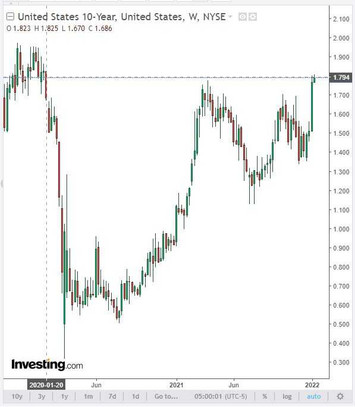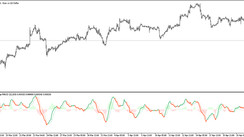Amid today's meager economic calendar, the dollar strengthened during today's Asian trading session. As of this writing, the DXY dollar index futures are traded near 95.94, 22 points above Friday's close when the dollar fell sharply due to an unjustified forecast for the NFP.
According to a report by the US Department of Labor, released last Friday, the number of new jobs created outside agriculture in December was 199,000, while almost double the number was expected. At the same time, the report reported a decrease in the unemployment rate to 3.9%, a new low during the pandemic, from the previous level of 4.2%.
Hourly earnings rose 0.6% to $ 30.31. Still, the dollar fell on Friday, as a Labor Department report with December data introduced some uncertainty that the Fed will start raising interest rates in March, although market participants still expect at least a threefold increase in interest rates in 2022. Taking into account the jobs created in December, the US economy now has 6.4 million more jobs than it had at the end of 2020, but still 3.6 million fewer than before the pandemic.
Meanwhile, the minutes of the Fed's December meeting, released last Wednesday, hinted at a propensity for a sharper reduction in the central bank's asset balance and the possibility of an earlier start of the cycle of raising interest rates. In view of this, the dollar retains the potential for further strengthening, also receiving support from the growing yields on government bonds. As you know, the yield on government bonds is growing against the background of growth in their sales. Accordingly, the sale of government bonds leads to an increase in demand for the national currency and to its strengthening.

Thus, the yield on US 10-year Treasury bonds at the time of publication of this article is 1.794% and has been holding near the maximum since February 2020, just before the March emergency Fed meetings, when the interest rate was sharply reduced from 1.75%, first to 1. 25%, and then to the current 0.25%.
Most likely, on expectations of the early start of the cycle of increasing interest rates by the Fed, the yield on US government bonds will continue to grow, and the dollar, accordingly, will strengthen.
As for today's economic calendar, market volatility did rise early in the Asian trading session today, just after the Australian Bureau of Statistics released fresh inflation and building permit data.
As a rule, this indicator causes volatility in the AUD rate, since when calculating this indicator, the statistics of the movement of corporate investments are taken into account, i.e. it reflects the economic dynamics of Australia. The more the number of resolutions, the more positive (or bullish) this factor is for the AUD. As follows from the report, in November the number of building permits increased by 3.6%, which turned out to be higher than the zero forecast after declining in the previous months by -13.6% and -4.3%.
Volatility in the AUD / USD pair will rise again tomorrow morning when the Australian Bureau of Statistics releases fresh retail sales and trade balance data at 00:30 (GMT). The retail sales index is often considered an indicator of consumer confidence and reflects the health of the retail sector in the near term. A rise in the index is usually positive for the AUD; a decrease in the indicator will negatively affect the AUD. The previous value of the index (in October) was +4.9% (after an increase of +1.3% in September and a decrease of -1.7% in August). If the data turns out to be weaker than the previous value, then the AUD may sharply decline in the short term, above the previous values, then the AUD is likely to strengthen. Forecast for November: +3.9%.






